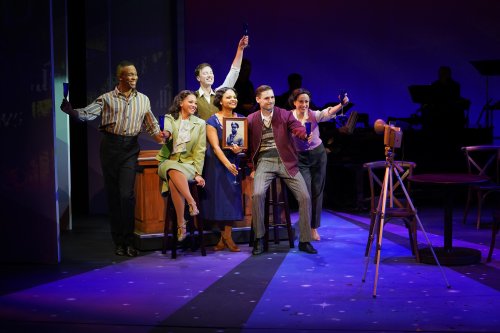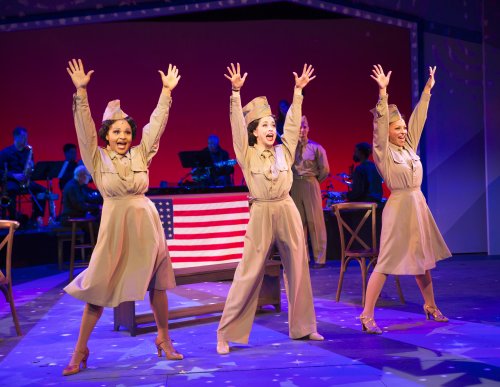Hoagy Carmichael’s Stardust Road
The York Theatre Company strikes gold again with a treasure trove of classic and some lesser known American Songbook fixtures from the pen of Hoagy Carmichael.

The company of The York Theatre Company’s new musical revue “Hoagy Carmichael’s Stardust Road” at the Theatre at St. Jeans (Photo credit: Carol Rosegg)
[avatar user=”Tony Marinelli” size=”96″ align=”left”] Tony Marinelli, Critic[/avatar]
The York Theatre Company’s masthead reads “Where Musicals Come to Life…” and that couldn’t be more evident in their new production, Hoagy Carmichael’s Stardust Road. Originally scheduled for a Fall 2015 run at London’s St. James Theatre (cancelled due to a key investor pulling out), then workshopped during a summer student production at Indiana University’s Department of Theatre, Drama and Contemporary Dance in 2018, the show finally arrives in a beautifully crafted production at York’s Theatre at St Jeans, deserving of an open-ended run or commercial transfer.
Conceived by director Susan H. Schulman, choreographer Michael Lichtefeld and musical arranger Lawrence Yurman, and developed with Hoagy Bix Carmichael (Hoagy’s son), Hoagy Carmichael’s Stardust Road succeeds not by showing the audience another “And Then I Wrote” compendium, but by allowing the endless riches of the Carmichael songwriting catalogue to say it with music. We are treated to five extended “parts” where we meet seven characters, all friends, as they traverse the decades from the 1920’s to the 1950’s, through every high point and every heartache.
Part One finds us in the Stardust Roadhouse, somewhere in Indiana, just as it has been sold to new owners, who may very well tear it down to develop. The opening moment gives us a medley of “Stardust”, “Moon Country”, “Ole Buttermilk Sky” “In the Cool, Cool, Cool of the Evening”, “Riverboat Shuffle”, tying it up with a bow of a reprise of “In the Cool, Cool, Cool of the Evening”, indicative of the vast brilliance of the material. While it is the intention to show us the growing pains of these seven individuals over the course of 90 minutes (four decades), the audience is forgiven if they get lost in the music. Part One has mighty gems in “Lazy River,” “Come Easy Go Easy Love,” “Ain’t There Anyone Here for Love?,” “When Love Goes Wrong (Nothin’ Goes Right)” and “Just a Shade on the Blue Side.”

Danielle Herbert, Sara Esty and Kayla Jenerson in a scene from The York Theatre Company’s new musical revue “Hoagy Carmichael’s Stardust Road” at the Theatre at St. Jeans (Photo credit: Carol Rosegg)
Part Two finds us at Club Old Man Harlem in New York City. “The Rhumba Jumps” gives us our first close look at dancer-singer-dancer-actor-dancer Cory Lingner, a performer that brings to mind what it must have felt like to experience the sheer dazzle of a young Tommy Tune, who for decades has defined the Broadway “hoofer who can sing too”… Years from now you will fondly remember the goosebumps Cory gave you in this show. This part is truly blessed with fine voices as we hear in Sara Esty and Dion Simmons Grier rendition of “Two Sleepy People,” and Kayla Jenerson in “The Nearness of You.”
Part Three places us in the USO Canteen. Wartime created separation from loved ones and therein some of the most beloved songs that haunt us to this day with their depiction of yearning for home and the ones we left behind. Director Schulman and arranger Yurman juxtapose four of those masterpieces in this section: “Memphis in June,” “Can’t Get Indiana off My Mind,” “Georgia on My Mind,” and “A World of No Goodbyes.” We see four soldiers each in their stages of duty and in the anticipation of returning to home, all except for one whose loved one we watch as she does not understand that the elaborate folding of the American flag will be the takeaway, in place of her beau who went off to war. It is the one terribly somber moment in a show that is otherwise filled to the brim with so much joy.
Part Four takes us to Club Heart and Soul, Hollywood, where like with all the other Tin Pan Alley songwriters Carmichael’s career went on to flourish. The songs that came out of this period include “Lyin’ to Myself,” “How Little We Know,” “I Get Along Without You Very Well,” and the legendary “Skylark” and “Stardust.”

Danielle Herbert, Cory Lingner, Mike Schwitter, Dion Simmons Grier and Markcus Blair in a scene from The York Theatre Company’s new musical revue “Hoagy Carmichael’s Stardust Road” at the Theatre at St. Jeans (Photo credit: Carol Rosegg)
The very brief Part Five brings us back to The Stardust Roadhouse years later, for a reopening of the venue in an effort to recapture that youthful innocence of decades before. The ghost of the soldier offers a touching “Serenade to Gabriel” while watching the rest of his friends recreating the décor to even the most minute detail. The song here, denotative of the last 90 minutes, is the to-the- point “I Walk with Music.”
Director Schulman keeps the story of these seven friends moving sensitively from life moment to life moment. The show’s concept of not one spoken word fits hand in glove with Carmichael’s music and the artist’s palette of lyricists he was blessed to work with. Lichtefeld’s dazzling choreography so firmly places us in every period. Yurman has created arrangements so inventive yet so faithful to Carmichael’s original intentions. Scenic design of James Morgan and Vincent Gunn effortlessly comes together from period to period complemented by Jason Kantrowitz’s faithful lighting design so attuned to the bright joyous moments of the full cast scenes and then the personal moments of the solos. Alex Allison’s costumes for the show are a triumph in every way, from the attention to everyday fashions to the glamour of the nights out in every era.
The cast of seven are each given many moments to shine in this show. From the very first duet of Sara Esty and Cory Lingner in “Lazy River” we know we are in very good hands. Markcus Blair finds the tongue-in-cheek humor in “Gonna Get a Girl” and the poignancy of “Blue Orchids.” His rendition of “Memphis in June” is an emotive set-up for the first of the four USO Canteen hallmarks and “Lyin’ to Myself” is a so truthful chasing the blues away. Mike Schwitter’s affecting “Stardust” paired with Kayla Jenerson’s reprise of “Ain’t There Anyone Here for Love?” is a stellar arrangement. Schwitter carries us tearfully through the contemplation of “A World of No Goodbyes” and reminds us of our own heartrending lies in “I Get Along Without You Very Well.” This, like so many of Carmichael’s songs, really does speak to us in the most personal ways – we hear the songs and know that he’s talking directly to us (and about us).

Danielle Herbert, Markcus Blair, Sara Esty, Cory Lingner and Kayla Jenerson in a scene from The York Theatre Company’s new musical revue “Hoagy Carmichael’s Stardust Road” at the Theatre at St. Jeans (Photo credit: Carol Rosegg)
Danielle Herbert so pitifully reveals the resignation of accepting the here today and gone tomorrow “Come Easy, Go Easy Love,” the giddy yet shy young love so charming in “Ooh! What You Said,” and the innocent lack of second-guessing new love in “How Little We Know.” Jenerson gives us all the laughs in the not so subtle “Ain’t There Anyone Here for Love?,” a true to the point explanation of her passion in “The Nearness of You” and a luscious rendition of “Stardust.” Dion Simmons Grier’s warm smile masks the real hidden humor in “When Love Goes Wrong (Nothin’ Goes Right)” and “No More Toujours L’Amour” but then pulls out all the stops on a priceless “Georgia on My Mind” and the touching melancholy “Serenade to Gabriel.”
Esty gives an impassioned response to a love that is gone before she got to enjoy it in “Just a Shade on the Blue Side” and later takes over the room in the very direct “Sing Me a Swing Song (and Let Me Dance).” She holds nothing back in a gutsy and emotional “Skylark.” Lingner just teases in a dynamic “The Rhumba Jumps” and if you were wondering if he can really sing he pours his heart into “Can’t Get Indiana off My Mind” before wowing us again with the exhausting, breathless “Cosmics.”
So much wonderful music here in the songs we know and the treasures we discover…not bad for a guy who worked in construction, and in a bicycle-chain factory, and in a slaughterhouse…oh yes, and as a lawyer…before “settling” as a music maker.
Hoagy Carmichael’s Stardust Road (through December 31, 2022)
The York Theatre Company
Theatre at St. Jeans, 150 East 76th Street, in Manhattan
For tickets, visit http://www.ovationtix.com
Running time: 90 minutes without an intermission






Leave a comment